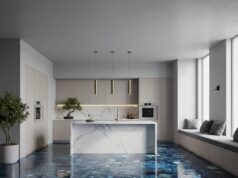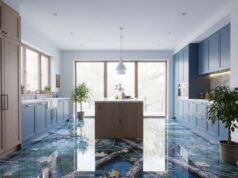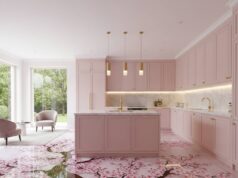In the realm of interior design, staircases are no longer mere functional elements facilitating movement between floors. They have evolved into statement pieces that define the aesthetic and ambiance of a space. Among the myriad of staircase designs, Waterfall Staircases stand out for their seamless blend of form and function, offering a harmonious flow that elevates the visual appeal of any home. This article delves deep into the essence of Waterfall Staircases, exploring their design intricacies, benefits, and transformative potential for modern living spaces.
The Essence of Waterfall Staircases
At its core, a Waterfall Staircase is characterized by its open risers and continuous treads that create an illusion of flowing water cascading down. This design eliminates the traditional vertical elements, resulting in a sleek and airy structure that embodies elegance and fluidity. The absence of risers not only enhances the visual lightness but also allows for unobstructed views across different levels of the home, fostering a sense of openness and connectivity.
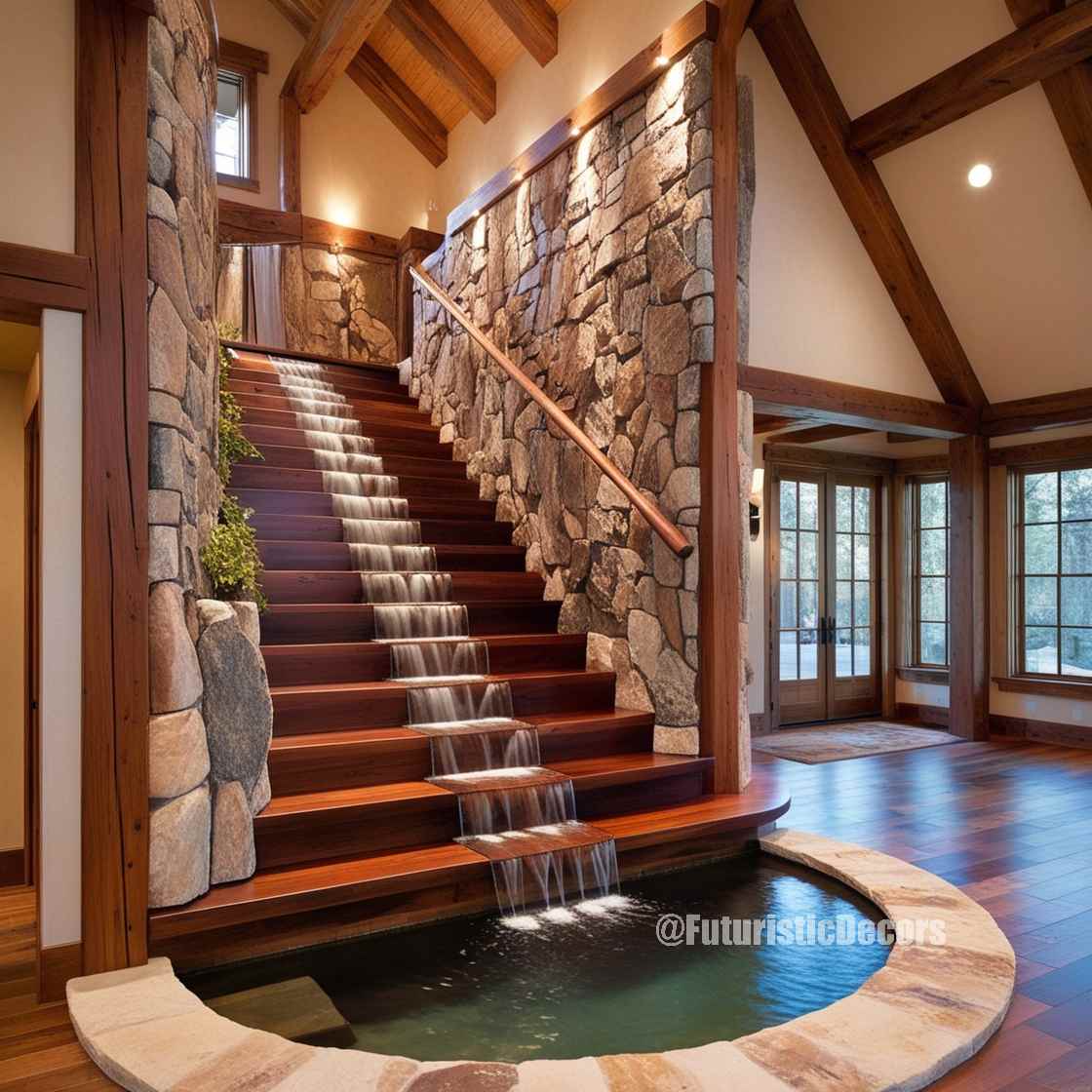
Visual Fluidity and Elegance
The hallmark of a Waterfall Staircase is its seamless, uninterrupted lines that mimic the natural flow of water. This fluidity imparts a sense of grace and sophistication, making the staircase a focal point in any room. Whether crafted from wood, glass, metal, or a combination of materials, the design exudes a contemporary charm that complements various architectural styles, from minimalist to industrial.
Versatility in Design
One of the standout features of Waterfall Staircases is their versatility. They can be tailored to fit the unique spatial and aesthetic requirements of different homes. Whether integrated into open-plan lofts, grand entryways, or compact apartments, the flowing design adapts seamlessly, enhancing the overall architectural narrative.
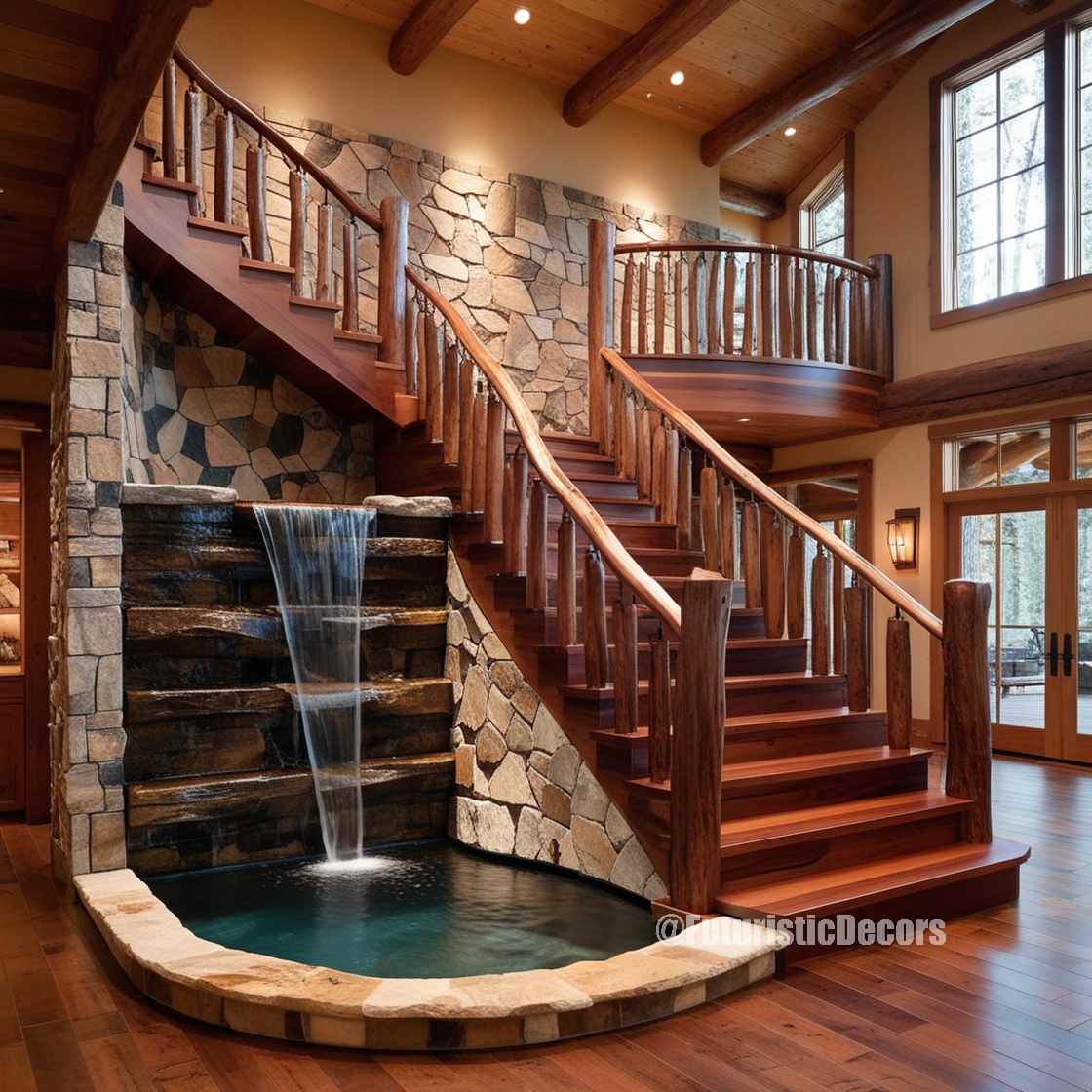
Historical Evolution of Waterfall Staircases
To fully appreciate the modern Waterfall Staircase, it’s essential to trace its historical roots and evolution. Staircase design has always been a reflection of the prevailing architectural trends and technological advancements.
Early Beginnings
Staircases have been integral to human dwellings for millennia, serving both practical and symbolic purposes. Early designs were predominantly functional, focusing on durability and ease of use. However, as architectural styles evolved, so did staircase designs, becoming more ornate and expressive.

Modern Minimalism
The advent of modernism brought a shift towards minimalism, emphasizing clean lines, simplicity, and functionality. Waterfall Staircases emerged as a manifestation of this movement, stripping away unnecessary embellishments to highlight the beauty of form and material. Their open design resonated with the minimalist ethos, offering a statement of understated elegance.
Contemporary Innovations
In recent years, Waterfall Staircases have continued to evolve, incorporating innovative materials and technologies. From glass balustrades illuminated by LED lighting to sustainably sourced woods and metal alloys, contemporary designs push the boundaries of aesthetics and functionality. These innovations not only enhance the visual appeal but also improve safety and durability, making Waterfall Staircases a practical choice for modern homes.

Design Elements of Waterfall Staircases
Creating a Waterfall Staircase involves a delicate balance of various design elements. Each component plays a pivotal role in achieving the desired flow and elegance.
Material Selection
The choice of materials is fundamental in defining the character of a Waterfall Staircase. Commonly used materials include:
- Wood: Offers warmth and natural beauty. Hardwood options like oak, walnut, and maple are popular for their durability and rich textures.
- Glass: Adds a contemporary and airy feel. Glass balustrades and treads can create a transparent effect, enhancing the sense of space.
- Metal: Provides a sleek and industrial touch. Stainless steel, wrought iron, and aluminum are often used for railings and structural supports.
- Concrete: Contributes to an industrial aesthetic. Polished concrete treads can offer a modern and robust appearance.
Structural Design
The structural integrity of a Waterfall Staircase is paramount. The open risers require precise engineering to ensure stability and safety. Typically, stringers or metal frames support the treads, ensuring that the staircase can bear the weight and usage demands.
Lighting Integration
Lighting plays a crucial role in accentuating the flowing design of a Waterfall Staircase. Strategically placed lights can highlight the staircase’s contours and materials, creating dramatic effects. Options include:
- LED Strip Lighting: Integrated into the stringers or beneath the treads to provide a subtle glow.
- Pendant Lights: Suspended above the staircase to add visual interest and ambient lighting.
- Understair Lighting: Illuminates the steps from below, enhancing visibility and safety.
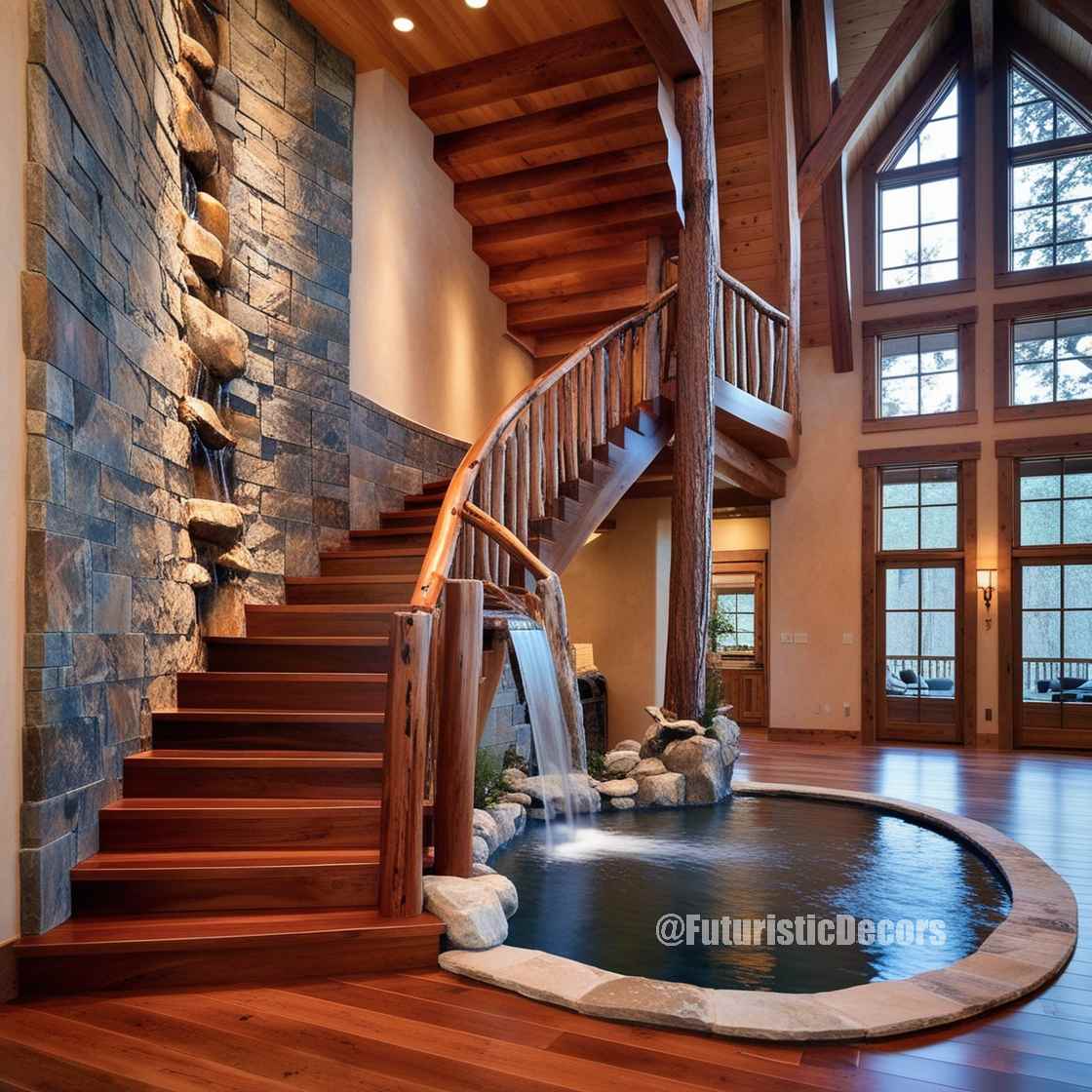
Color Palette
The color scheme of a Waterfall Staircase should harmonize with the overall interior design. Neutral tones like whites, grays, and blacks offer timeless elegance, while bold colors can make the staircase a striking focal point. The interplay of colors between the treads, balustrades, and surrounding spaces contributes to the staircase’s visual appeal.
Balustrade Design
Balustrades provide safety and aesthetic continuity. In Waterfall Staircases, balustrades are often minimalistic, using thin metal rails or clear glass panels to maintain the open and flowing design. The choice of balustrade style can significantly influence the staircase’s overall look, from ultra-modern to classic.
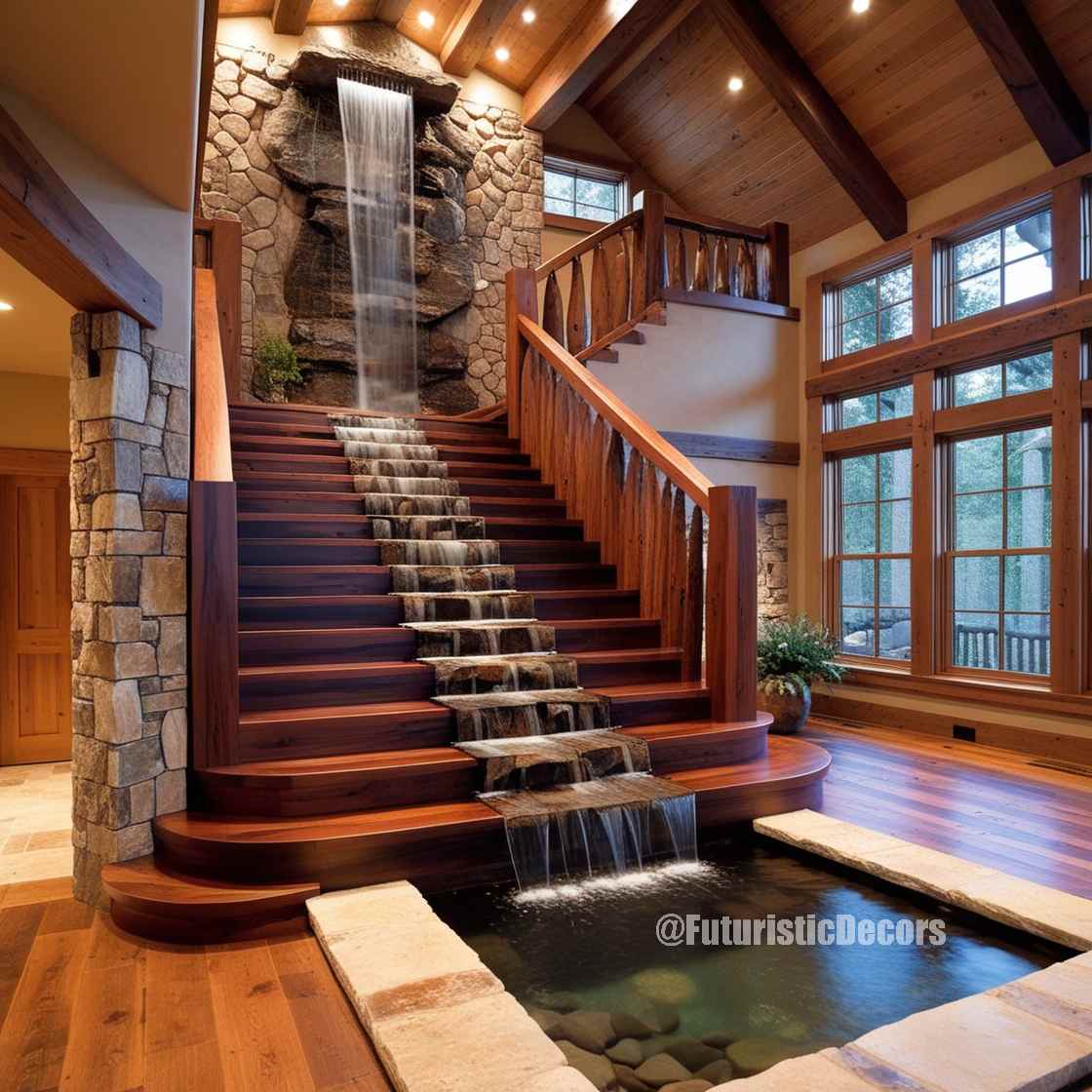
Benefits of Waterfall Staircases
Investing in a Waterfall Staircase offers numerous advantages that extend beyond mere aesthetics. These benefits encompass functional, spatial, and value-enhancing aspects of home design.
Enhanced Visual Appeal
The most immediate benefit of a Waterfall Staircase is its stunning visual impact. The flowing lines and open design create an elegant centerpiece that elevates the interior decor. This aesthetic enhancement can transform the ambiance of entire spaces, making them more inviting and sophisticated.
Space Optimization
Waterfall Staircases are ideal for spaces where maximizing openness is a priority. The absence of risers reduces the staircase’s footprint, allowing for more flexible use of space. This design is particularly beneficial in open-plan layouts, where maintaining a sense of continuity and flow is essential.
Increased Natural Light
The open design allows natural light to permeate through the staircase area, brightening the space and creating a more airy atmosphere. This increased light can enhance the overall mood of the home, making rooms feel more spacious and connected.
Modern and Timeless Appeal
Waterfall Staircases embody a modern aesthetic that transcends fleeting design trends. Their clean lines and minimalist approach ensure that they remain stylish and relevant, adding lasting value to the home.
Customization and Personalization
The versatility in design allows homeowners to customize Waterfall Staircases to reflect their personal style and preferences. From selecting materials and colors to incorporating unique lighting solutions, the possibilities for personalization are extensive, ensuring that each staircase is a unique expression of the homeowner’s vision.
Increased Property Value
A well-designed Waterfall Staircase can significantly enhance the value of a property. Potential buyers are often drawn to unique and stylish architectural features, and a stunning staircase can be a compelling selling point that distinguishes a home in the real estate market.
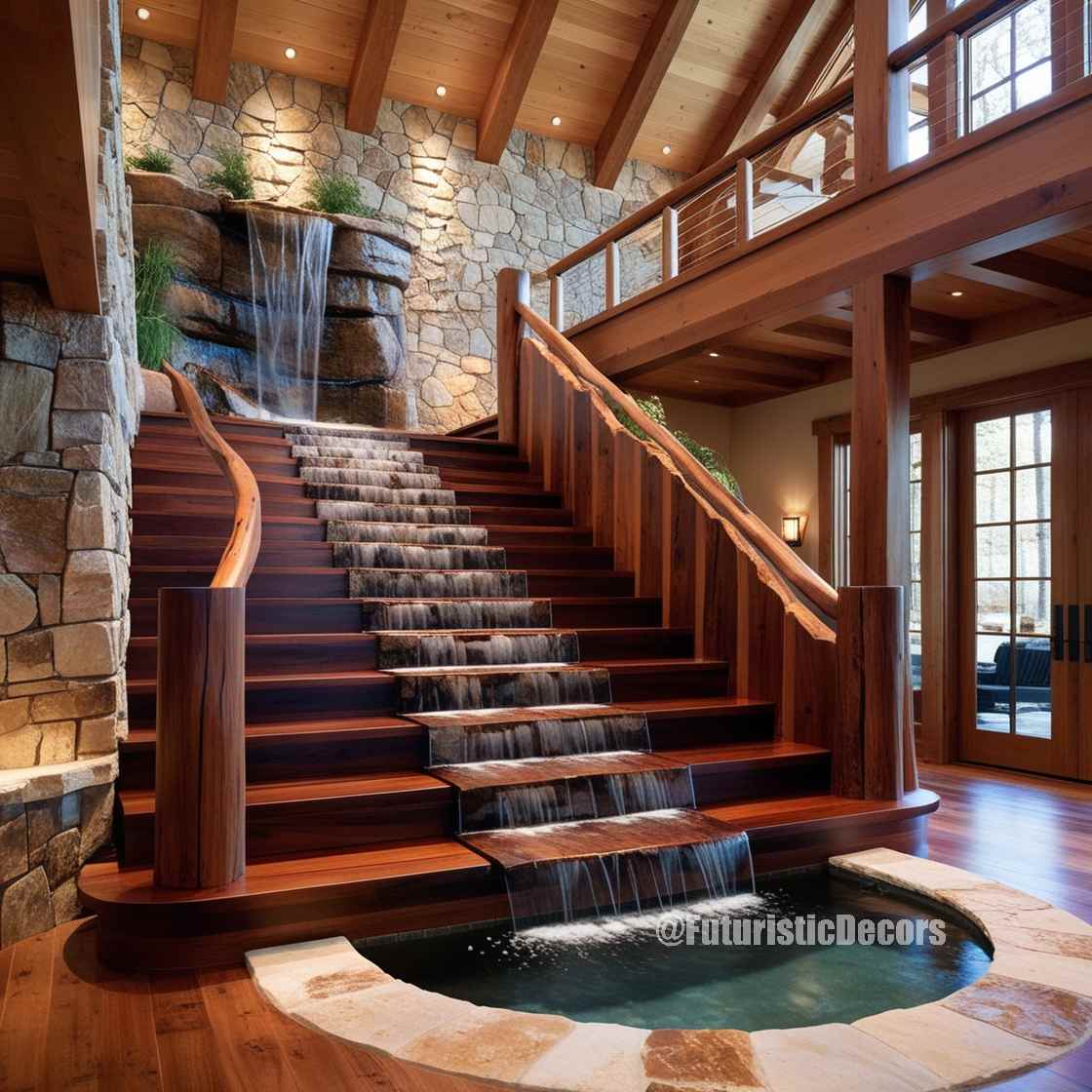
Installation Considerations for Waterfall Staircases
While the allure of Waterfall Staircases is undeniable, careful planning and consideration are essential to ensure a successful installation. Several factors need to be addressed to achieve both aesthetic and functional excellence.
Space Requirements
Assessing the available space is crucial. Waterfall Staircases require sufficient vertical and horizontal space to maintain their flowing design. Accurate measurements and spatial planning help in determining the optimal placement and dimensions of the staircase within the home.
Structural Integrity
Given the open risers and continuous treads, the structural framework must be robust. Engaging with experienced architects and builders ensures that the staircase meets safety standards and can support the intended load. Materials chosen for the framework should complement the overall design while providing the necessary strength.
Building Codes and Regulations
Compliance with local building codes and regulations is non-negotiable. These codes dictate aspects like tread depth, riser height, railing specifications, and overall safety measures. Ensuring adherence to these guidelines not only guarantees safety but also avoids potential legal issues.
Budget Planning
Waterfall Staircases can vary significantly in cost based on materials, design complexity, and customization levels. Establishing a clear budget early in the planning process helps in making informed decisions and prioritizing features that align with financial constraints.

Professional Expertise
Collaborating with skilled designers and contractors is essential for the successful execution of a Waterfall Staircase project. Their expertise ensures that the design is both aesthetically pleasing and structurally sound, navigating challenges that may arise during installation.
Timeline Management
Understanding the project’s timeline helps in coordinating various stages, from design and material selection to construction and finishing touches. Setting realistic deadlines and allowing for contingencies ensures a smooth and timely installation process.
Integration with Home Styles
One of the strengths of Waterfall Staircases is their adaptability to various interior design styles. Whether aiming for a modern, minimalist, industrial, or traditional look, the staircase can be tailored to complement and enhance the existing decor.
Modern and Contemporary
In modern and contemporary homes, Waterfall Staircases serve as a striking focal point. Utilizing materials like glass, steel, and light-colored woods aligns with the sleek and clean lines typical of these styles. Integrated lighting and minimalist balustrades further accentuate the staircase’s modern appeal.
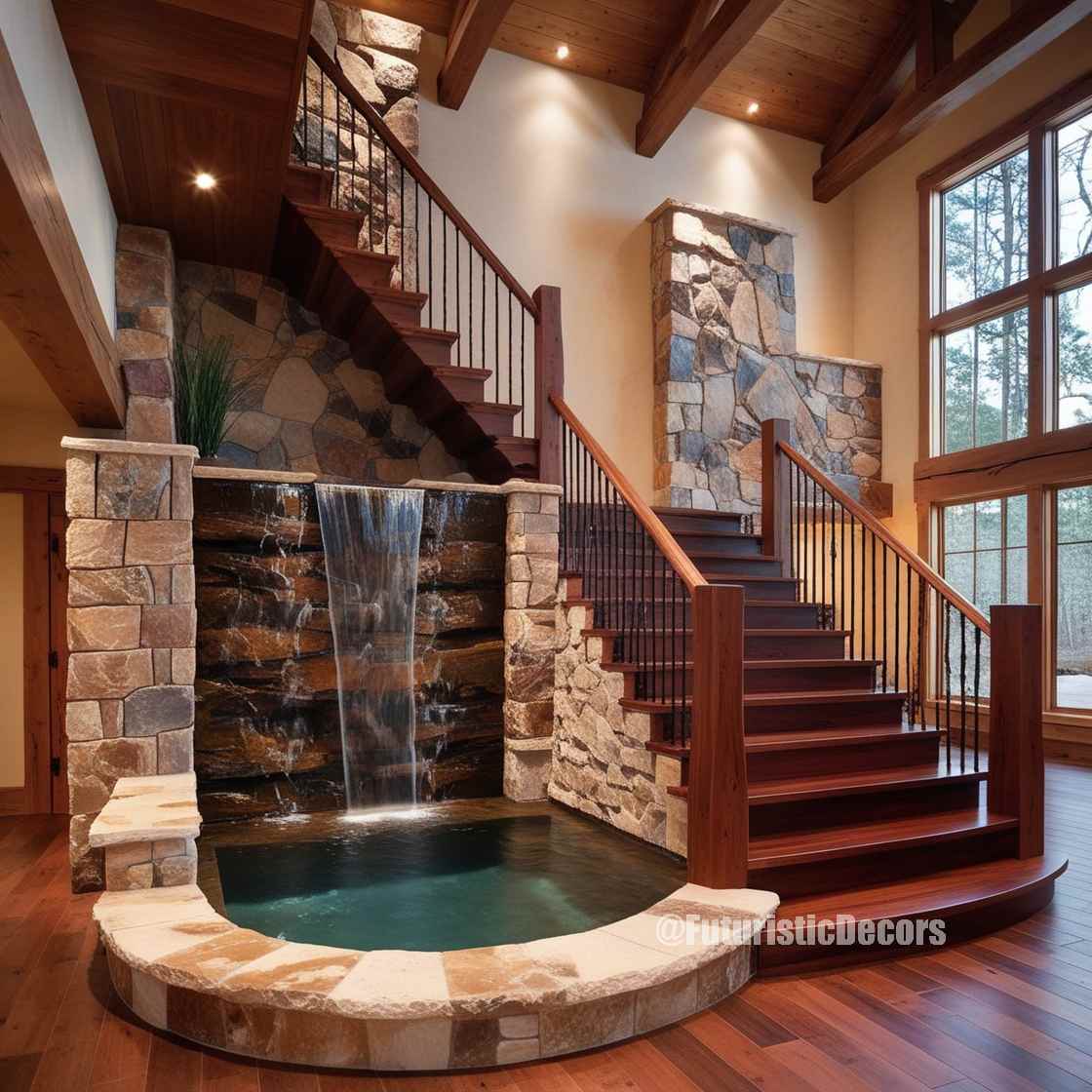
Minimalist
For minimalist interiors, the Waterfall Staircase embodies simplicity and functionality. The open design, neutral color palettes, and unadorned materials resonate with the minimalist ethos of “less is more.” This creates a serene and uncluttered environment that emphasizes the beauty of space and light.
Industrial
In industrial-themed homes, Waterfall Staircases can incorporate raw and rugged materials like exposed steel and reclaimed wood. The combination of metal and wood adds texture and character, aligning with the industrial aesthetic’s emphasis on utilitarian and unfinished elements.
Traditional and Classic
While Waterfall Staircases are inherently modern, they can be adapted to suit traditional and classic interiors. Using ornate wood finishes, wrought iron railings, and warm color tones can blend the staircase seamlessly into a more classic decor, adding a touch of elegance and sophistication.
Eclectic
In eclectic interiors, the versatility of Waterfall Staircases allows for creative and personalized designs. Mixing different materials, colors, and styles can result in a unique staircase that reflects the homeowner’s personality and diverse design influences.
Maintenance and Durability
Ensuring the longevity and pristine appearance of a Waterfall Staircase requires regular maintenance and careful selection of durable materials.
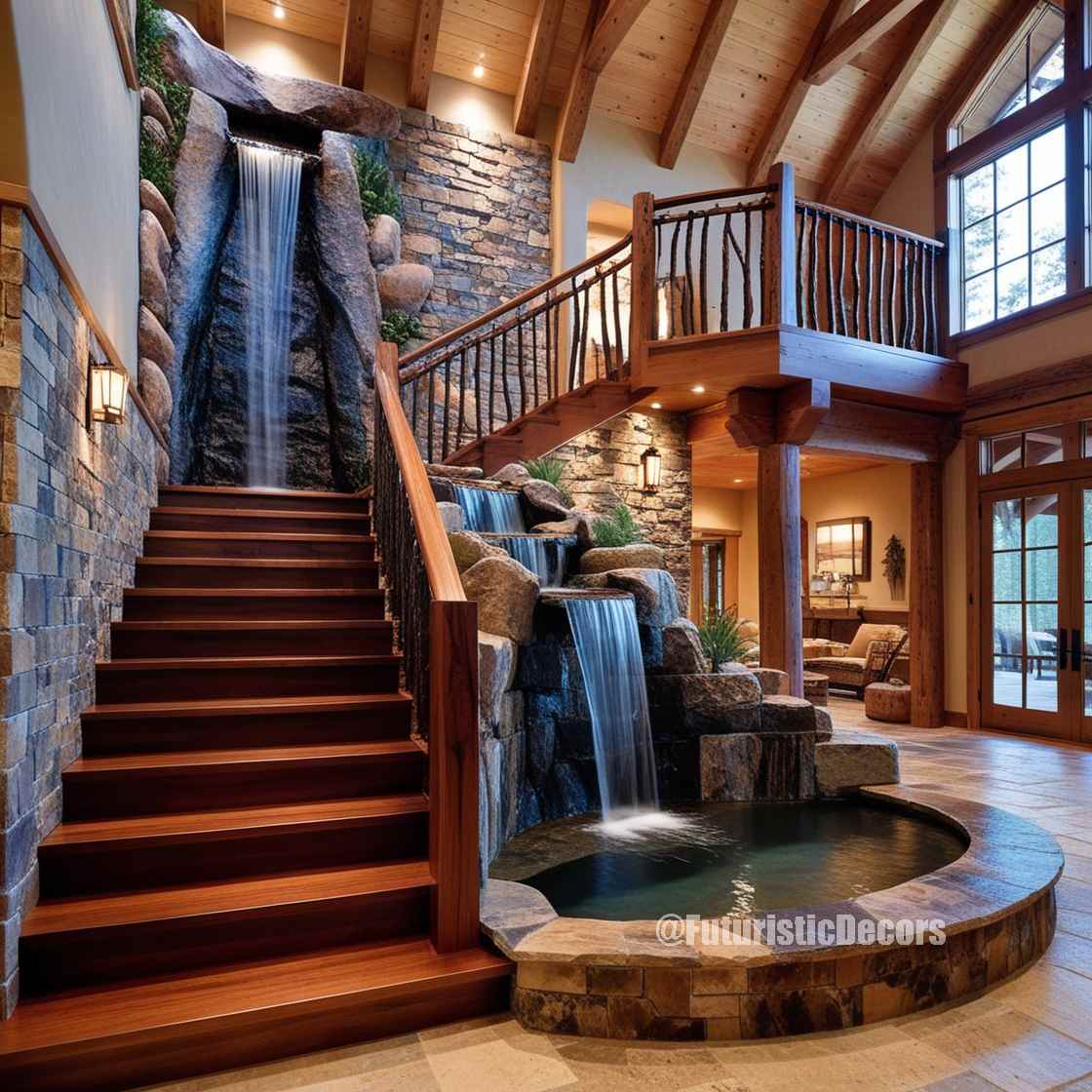
Material-Specific Care
- Wood: Requires periodic cleaning and treatment to prevent warping and discoloration. Using finishes like varnish or sealant can protect the wood from moisture and wear.
- Glass: Needs regular cleaning to maintain transparency and shine. Using appropriate glass cleaners and soft cloths prevents scratches and streaks.
- Metal: Should be kept free from rust and corrosion. Applying protective coatings and cleaning with suitable products ensures the metal remains in excellent condition.
- Concrete: Requires sealing to protect against stains and moisture. Regular cleaning helps maintain its polished appearance.
Routine Inspections
Regularly inspecting the staircase for signs of wear, loose components, or structural issues is essential. Early detection of problems allows for timely repairs, ensuring the staircase remains safe and visually appealing.
Professional Maintenance
Engaging professionals for periodic maintenance checks and repairs can extend the lifespan of a Waterfall Staircase. Their expertise ensures that any issues are addressed correctly, preserving the staircase’s integrity and beauty.
Case Studies: Transformative Waterfall Staircases
Examining real-world examples of Waterfall Staircases can provide inspiration and practical insights into their transformative potential. Here are a few illustrative scenarios:
Loft Apartment with Industrial Flair
In a loft apartment characterized by exposed brick walls and steel beams, a Waterfall Staircase with metal stringers and reclaimed wood treads serves as a central feature. The open design complements the industrial aesthetic, while integrated LED lighting highlights the staircase’s contours, enhancing the space’s modern and edgy vibe.
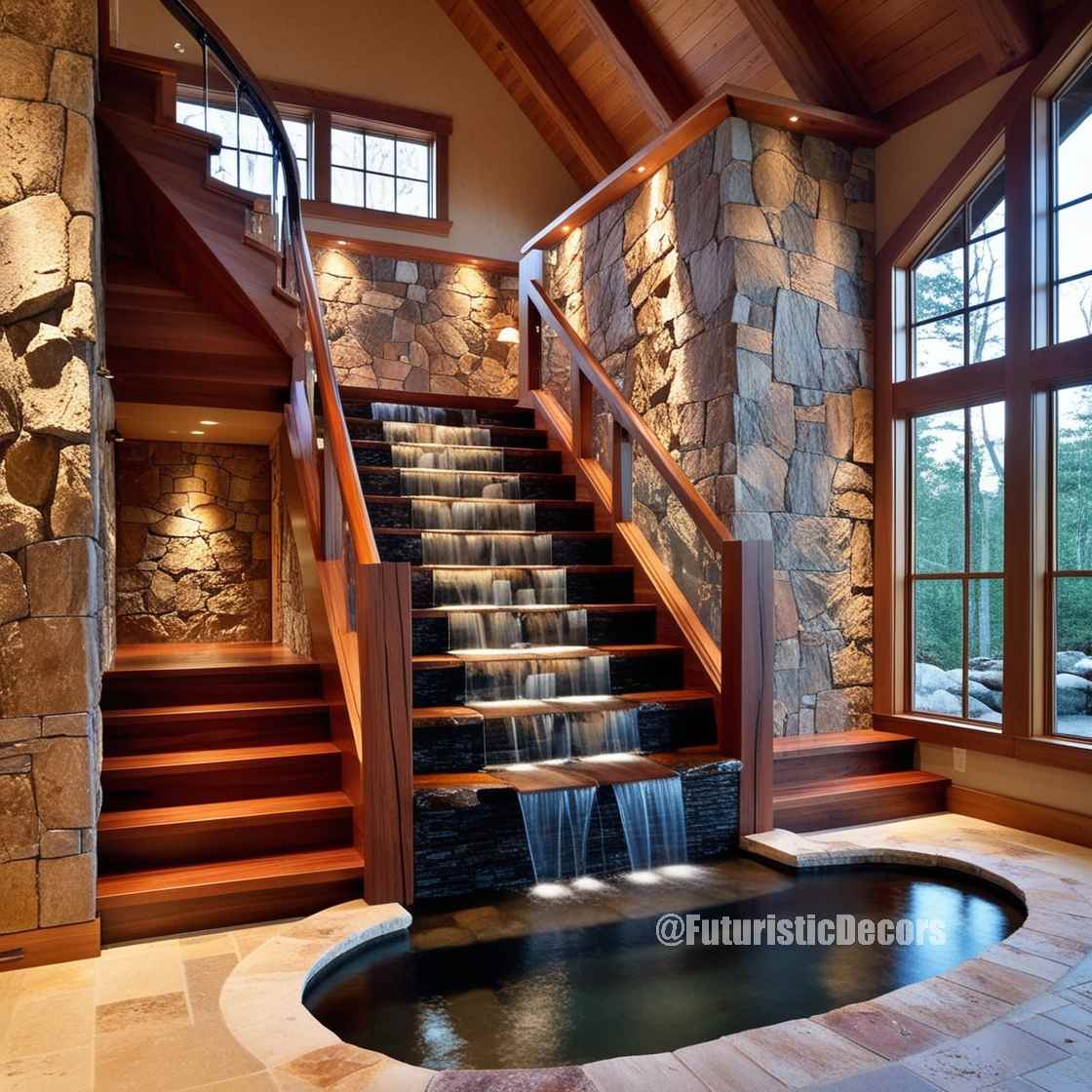
Contemporary Family Home
A spacious family home with an open-plan living area incorporates a Waterfall Staircase with light oak treads and glass balustrades. The staircase connects the ground floor to the upper levels seamlessly, allowing natural light to flow through. The minimalist design ensures that the staircase blends harmoniously with the contemporary decor, providing both functionality and elegance.
Modern Minimalist Studio
In a compact studio apartment, a space-saving Waterfall Staircase with floating steps and slim metal railings maximizes the available space without compromising on style. The staircase’s open design creates an illusion of expanded space, making the studio feel larger and more inviting. The neutral color palette aligns with the minimalist theme, ensuring a cohesive look.
Luxury Penthouse
A luxury penthouse features a grand Waterfall Staircase with polished marble treads and a striking glass balustrade. The staircase acts as a statement piece, connecting multiple levels with grace and sophistication. Custom lighting fixtures illuminate the staircase, adding a touch of glamour and enhancing the penthouse’s upscale ambiance.
Trends and Innovations in Waterfall Staircases
The design landscape is ever-evolving, and Waterfall Staircases are no exception. Emerging trends and innovations continue to push the boundaries, offering fresh perspectives and enhanced functionalities.
Sustainable Materials
With growing environmental consciousness, there is an increasing emphasis on using sustainable and eco-friendly materials in Waterfall Staircases. Reclaimed wood, recycled metals, and low-VOC finishes are becoming popular choices, aligning with the principles of sustainable design and reducing the environmental footprint.
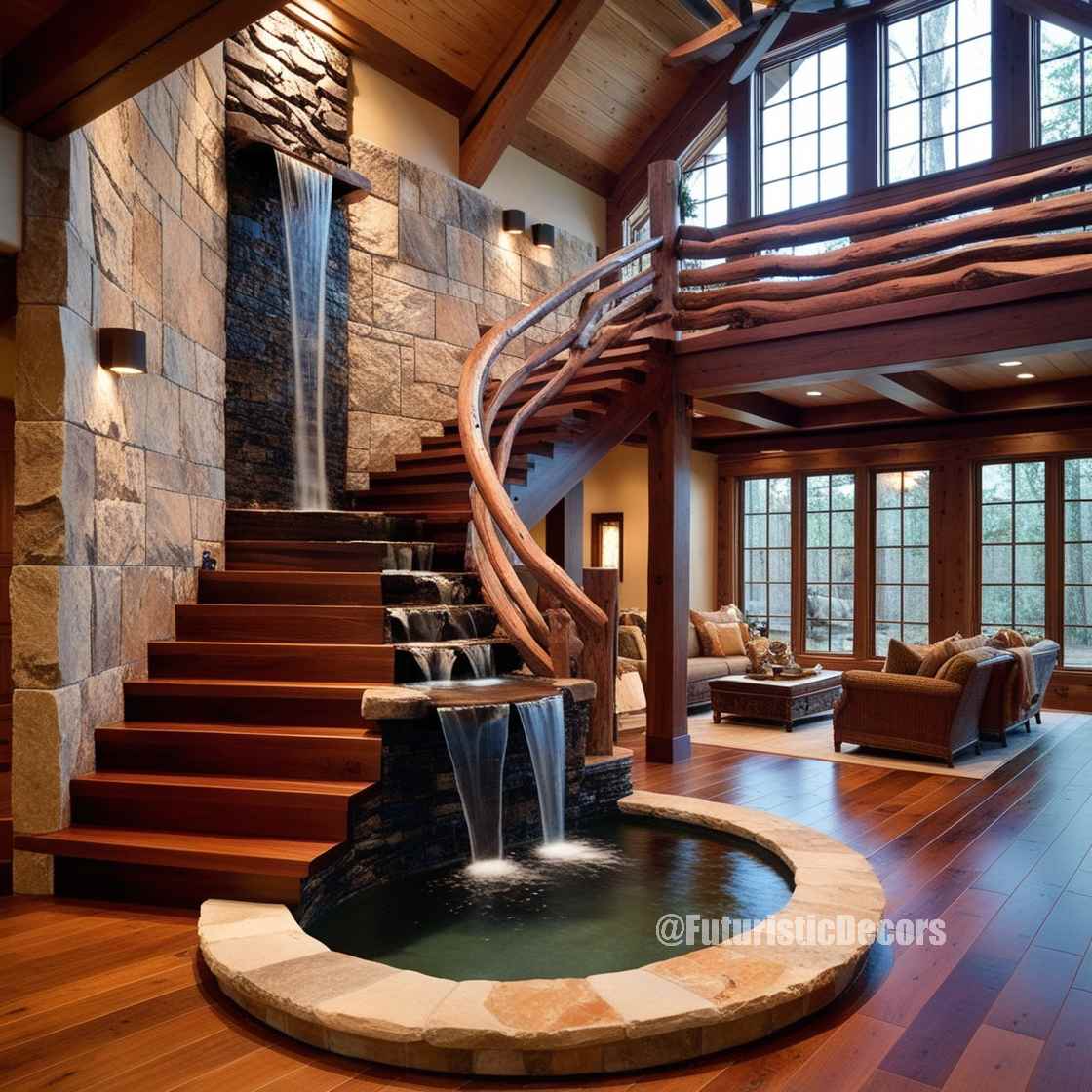
Smart Lighting Solutions
Advancements in lighting technology have led to the integration of smart lighting systems in Waterfall Staircases. Automated LED lighting that adjusts based on movement or time of day enhances both functionality and ambiance. These smart solutions offer energy efficiency and customizable lighting effects, allowing homeowners to create dynamic and responsive environments.
Modular and Prefabricated Designs
Modular and prefabricated Waterfall Staircases offer greater flexibility and ease of installation. These designs can be customized to fit specific spaces and preferences while reducing construction time and costs. Prefabricated components ensure precision and consistency, making them an attractive option for both residential and commercial applications.
Mixed-Material Combinations
Combining different materials is a trend gaining traction in Waterfall Staircases. The juxtaposition of wood and glass, metal and concrete, or stone and acrylic creates visually striking contrasts and adds depth to the design. These mixed-material combinations allow for greater creativity and personalization, resulting in unique and captivating staircases.
Integrated Technology
Incorporating technology into Waterfall Staircases enhances their functionality and user experience. Features such as built-in storage, hidden lighting controls, and interactive elements can be seamlessly integrated, adding convenience and modernity to the staircase design.
Artistic and Sculptural Elements
Some designers are exploring the artistic potential of Waterfall Staircases by incorporating sculptural elements and artistic features. Custom balustrades, ornate stringers, and unique tread patterns can transform the staircase into a work of art, adding a distinctive and personalized touch to the home.
DIY vs. Professional Installation
Deciding between a DIY approach and professional installation is a critical consideration when planning a Waterfall Staircase.
DIY Installation
For those with carpentry skills and experience in construction, a DIY approach can be a cost-effective option. However, Waterfall Staircases require precise measurements, structural integrity, and adherence to safety standards, making DIY projects challenging for beginners. Mistakes can compromise the staircase’s stability and aesthetics, leading to costly repairs and potential safety hazards.
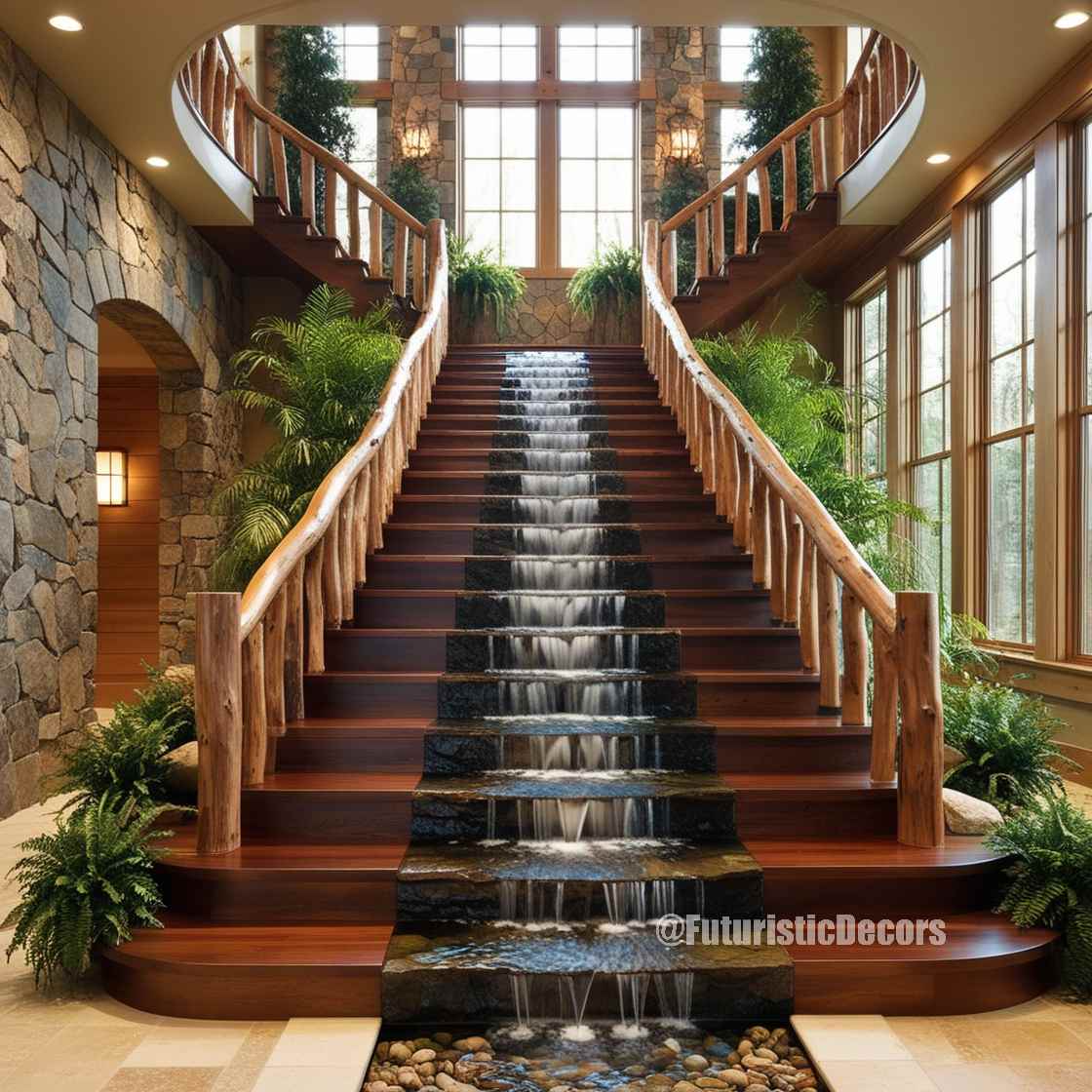
Professional Installation
Engaging professional designers and contractors ensures that the Waterfall Staircase is executed to the highest standards. Professionals bring expertise in design, material selection, structural engineering, and compliance with building codes. Their involvement minimizes risks, ensures quality craftsmanship, and results in a staircase that meets both functional and aesthetic expectations.
Hybrid Approach
A hybrid approach, where homeowners handle certain aspects of the project while relying on professionals for critical components, can offer a balance between cost savings and quality assurance. This approach requires clear communication and coordination to ensure that all elements integrate seamlessly.
Cost Factors of Waterfall Staircases
Understanding the cost implications is essential for budgeting and planning a Waterfall Staircase project. Several factors influence the overall cost, including:
Material Costs
The choice of materials significantly impacts the cost. Premium materials like marble, hardwood, and high-quality glass are more expensive, while alternatives like engineered wood or acrylic can offer cost savings without compromising aesthetics.
Design Complexity
Intricate designs with custom features, unique shapes, or artistic elements require more time and resources, increasing the overall cost. Simple, straightforward designs are generally more affordable and easier to install.
Labor and Expertise
Hiring skilled professionals comes at a higher cost but ensures quality and precision. The complexity of the project also affects labor costs, with more elaborate staircases requiring more time and specialized skills.
Customization and Finishing
Custom finishes, bespoke elements, and personalized features add to the cost. Standard finishes and off-the-shelf components are more budget-friendly, while customization allows for greater personalization but at a premium price.
Location and Accessibility
The location of the staircase within the home and the accessibility of the installation site can influence costs. Staircases in hard-to-reach areas may require additional materials and labor, increasing the overall expense.
Permits and Regulations
Obtaining necessary permits and ensuring compliance with building codes may involve additional costs. These fees vary based on local regulations and the scope of the project.
Maintenance Considerations
Choosing materials that require minimal maintenance can result in long-term cost savings. While some materials may have higher upfront costs, their durability and low maintenance needs can reduce ongoing expenses.
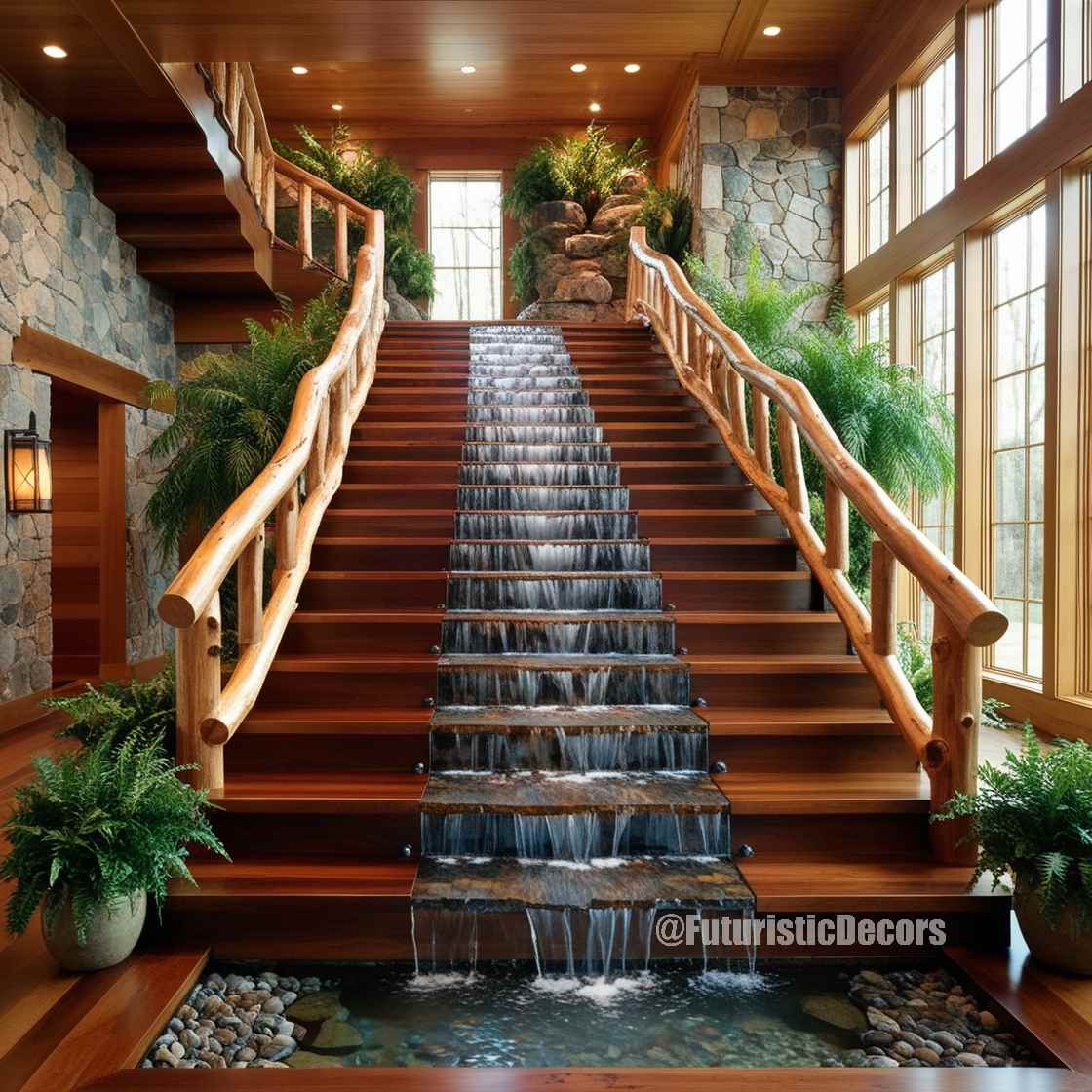
Maximizing the Impact of Your Waterfall Staircase
To truly transform your home with a Waterfall Staircase, consider the following strategies to maximize its impact:
Highlight with Lighting
Effective lighting can accentuate the staircase’s flowing lines and materials. Use a combination of ambient, task, and accent lighting to create a dynamic and inviting atmosphere. Highlighting specific features like the stringers or balustrades can add depth and dimension.
Create a Focal Point
Position the Waterfall Staircase in a prominent location to serve as a central focal point. Surrounding it with complementary decor, such as artwork, plants, or furniture, can enhance its visual prominence and integrate it seamlessly into the overall design.
Harmonize with Surroundings
Ensure that the staircase design harmonizes with the surrounding spaces. Coordinating colors, materials, and styles creates a cohesive flow throughout the home, making the staircase an integral part of the interior narrative.
Incorporate Functional Elements
Integrate functional elements like storage solutions, seating areas, or decorative displays within the staircase design. These additions not only enhance usability but also add character and interest to the staircase.
Personalize with Accessories
Add personal touches through accessories such as unique railings, custom treads, or artistic embellishments. These personalized elements make the staircase a unique reflection of your style and taste.
Maintain Cleanliness and Order
A clean and well-maintained Waterfall Staircase enhances its elegance and appeal. Regular cleaning and organization ensure that the staircase remains a beautiful and functional part of your home.
Sustainability and Eco-Friendly Waterfall Staircases
Incorporating sustainability into your Waterfall Staircase design aligns with eco-friendly living principles and contributes to environmental conservation.
Sustainable Material Choices
Opt for materials that are sustainably sourced, recycled, or have a low environmental impact. Certified wood, recycled metals, and eco-friendly composites reduce the ecological footprint of your staircase.
Energy-Efficient Lighting
Utilize energy-efficient lighting solutions, such as LED lights, to minimize energy consumption. Smart lighting systems that adjust based on usage can further enhance energy savings.

Longevity and Durability
Choosing durable materials and designs ensures that your Waterfall Staircase stands the test of time, reducing the need for replacements and minimizing waste. Investing in quality craftsmanship contributes to long-term sustainability.
Indoor Air Quality
Select materials and finishes that promote good indoor air quality. Low-VOC paints, sealants, and adhesives prevent the release of harmful chemicals, creating a healthier living environment.
Recyclability
Design the staircase with recyclability in mind, allowing for easier disassembly and recycling of materials at the end of its lifecycle. This approach supports a circular economy and reduces landfill waste.
Future-Proofing Your Waterfall Staircase
Designing a Waterfall Staircase with future-proofing in mind ensures that it remains relevant and functional as trends and needs evolve.
Timeless Design Elements
Incorporate timeless design elements that transcend fleeting trends. Classic materials, neutral color palettes, and simple forms ensure that the staircase remains stylish and adaptable.
Flexibility in Functionality
Design the staircase to accommodate changing needs. Modular components, adjustable features, and adaptable lighting solutions provide flexibility for future modifications or expansions.
Integration with Smart Home Technologies
Future-proof your Waterfall Staircase by integrating smart home technologies. Features like automated lighting, motion sensors, and smart controls enhance functionality and keep the staircase aligned with technological advancements.
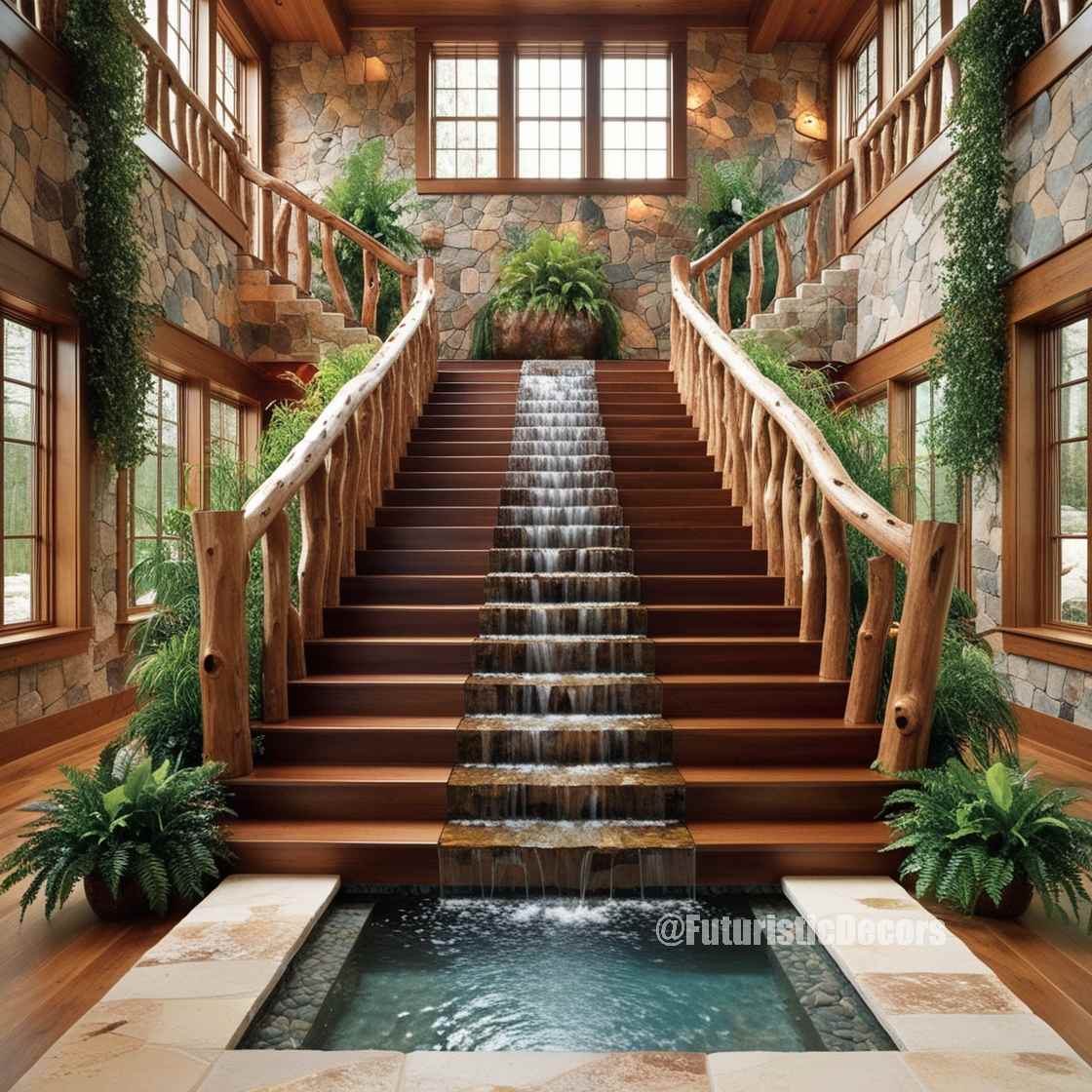
Durability and Quality
Investing in high-quality materials and construction ensures that the staircase can withstand the test of time and usage. Durable designs minimize the need for frequent repairs or replacements, maintaining the staircase’s integrity and appearance.
A Waterfall Staircase is more than just a functional element in a home; it is a testament to flowing elegance and modern design. Its seamless lines, open design, and versatile aesthetic make it a transformative feature that enhances the beauty and functionality of any living space. By carefully considering design elements, materials, and installation factors, homeowners can create a stunning Waterfall Staircase that serves as a central focal point and elevates the overall ambiance of their home.
Embracing the elegance of Waterfall Staircases allows for the creation of spaces that are both visually captivating and inherently functional. As design trends continue to evolve, the timeless appeal and adaptability of Waterfall Staircases ensure that they remain a cherished and enduring feature in contemporary home design.
FuturisticDecors is dedicated to exploring and showcasing innovative design solutions that blend aesthetics with functionality, transforming homes into elegant and harmonious living spaces.


